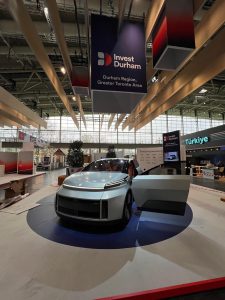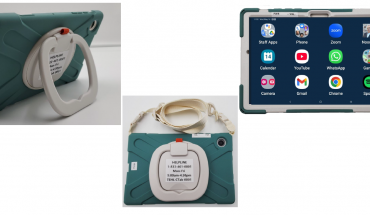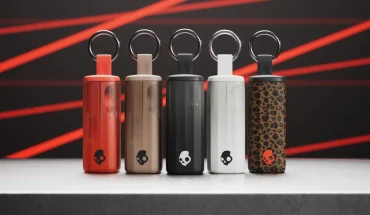Canada’s homegrown electric vehicle – that’s right, a car entirely made in this country – is not only futuristic, fast, and environmentally friendly, it has hit the target on its first appearance in Europe, attracting the attention of consumers, manufacturers, and government leaders from around the world.
Project Arrow 2.0 is a new automotive technology initiative from the students and faculty at Ontario Tech University – along with their many partners and collaborators from industry, academia, and government. The effort unites many Canadian automotive startups and major Tier 1 suppliers with leading experts and skilled students at Ontario Tech and other educational institutions.

The theme at the Hannover Messe trade show is emblazoned in its banner; Canadian technology is helping with that shaping.
The team is showing the latest version of their high-tech auto, the all-Canadian, zero emissions electric vehicle concept car, in Germany right now (at the giant Hannover Messe industrial trade show). The Arrow made its debut in 2023 at the Consumer Electronics Show (CES) in Las Vegas.
Among its many features, this cutting-edge EV can reach speeds of 180 km/h, with a driving range of some 500 km: it’s a 550-horsepower vehicle, powered by 80+ kilowatt batteries.
It’s equipped with a fully electric drive train, autonomous driving capabilities, and constructed using environmentally friendly materials. It can make use of artificial intelligence, machine learning and a bevy of sensors to boost its own safety and efficiency, and it can have bio-sensing capabilities to keep track of the driver or passenger, too.
Of course, there’s touchscreens and digital dashboards that drivers can use to see the vehicle’s performance – but there’s also some nice maple wood finishes and interior flooring to give the EV that ‘Canadian look and feel’.

Dr. Les Jacobs, Vice-President of Research and Innovation at Ontario Tech University, describes the all-Canadian Arrow at the Hannover trade show in Germany.
And, as Dr. Les Jacobs, Vice-President of Research and Innovation at Ontario Tech University, describes, among its many firsts, the car’s carbon chassis is produced on a 3-D printer!
“It’s the only car in the world that has its guts made with a 3-D printer,” he described. “That has created incredible interest, as most thought it couldn’t be done. Essentially, it is a single piece, printed on a complex 3-D printer. We’ve shown that it can be done, and using graphite, that opens the door for the idea of producing small run vehicles in less time, using less space.”
Another first: this low emission, clean-running car actually has a carbon capture device on its front end: “It’s cleaning the air as you drive,” Jacobs exclaims.
Also unique to the Arrow: every design and fabrication detail of the Arrow, from the decision on type and placement for every bolt, to the full installation and build, was completed on the Ontario Tech campus by a team of experts and future talent from the university’s engineering programs.
Ontario Tech University was designated the lead academic institution in Project Arrow’s initial development phase, starting back in 2021. As the official research and build partner for Canada’s Automotive Parts Manufacturers’ Association (APMA), the university leverages its engineering expertise and leadership to advance the project, with funding support from the Federal Economic Development Agency for Southern Ontario (FedDev).
The University’s Innovation Garage is where the Canadian industry partners, professors, researchers and students collaborate on the project. The Garage includes laboratories, as well as manufacturing facilities, offices and shared spaces to serve the needs of the project.

The Climatic Aerodynamic Wind Tunnel is where extreme weather conditions can be simulated to make sure the Arrow 2.0 can handle Canada’s harsh winters.
Some of the Arrow 2.0 development activities also take place at Ontario Tech’s ACE Core Research and Testing Facility, home to a giant Climatic Aerodynamic Wind Tunnel. Extreme weather conditions, from blizzards to hurricanes, can be simulated to make sure the Arrow 2.0 can handle Canada’s harsh winters.
Not just our weather, but our ability to test vehicles in it is another unique aspect of the project, Jacobs notes. “In southern California, they can’t really reproduce these conditions easily. Many of the major manufacturers come here.”
They all should.
The university and its network of partners combine to offer an ideal technology ecosystem for supporting innovation and commercialization across the automotive industry, an ecosystem that of course includes the students themselves.
For example, as Jacobs relates, one of the 20 or so students working on the project, 2024 Ontario Tech Automotive Engineering graduate Andrew Genovese, has since been hired by the APMA.
Genovese, who worked on tasks like body panel installation, suspension systems, brake lines, and motors during Phase 1 of the Arrow project will continue to participate as he has also been brought on to the Phase 2 advisory board. “He’ll get to rub shoulders with some of the industry’s superstars, from Germany and Italy,” Jacobs says with both pride and admiration.
And then, there’s the prestigious Professional Engineers Ontario (PEO) (York Chapter) Engineering Research Project of the Year award, presented to Ontario Tech University’s Advanced Digital Design, Manufacturing, and Metrology Laboratories for work on the project.
The Arrow is attention-grabbing. It is award-winning. It is job-creating. It symbolizes “what’s possible in Canada’s automotive industry when academia and industry partner to drive innovation,” Jacobs concludes.
The APMA says it’s also possible that by 2030, some two million Arrows could be sold each year, coming off all-Canadian assembly lines with models priced around $35,000.
So despite negative remarks you may have seen or heard about Canada’s low contributions to car culture in America (and pretty much the rest of its economy, as that country’s President apparently sees it), there is a track record of on-time and on-budget innovation here; Canada does have a growing global reputation for research excellence in energy, automotive, smart mobility, and advanced manufacturing engineering.

Invest Durham, representing the Ontario region’s businesses, institutions and students, hosts the display in Germany for Project Arrow, and the all-Canadian, zero emissions electric vehicle concept car, which it says provides proof of Canada and Durham Region’s rare engineering and advanced manufacturing talent. Invest Durham has partnered with Durham College, Ontario Tech University, Trent University Durham GTA and the Automotive Parts Manufacturers Association to demonstrate how talent, research and development and engineering expertise, come together to create industry leading innovation.
With tens of millions of dollars in funding from federal, provincial, and institutional sources, along with in-kind support from industry (Jacobs points out that some 60 different Canadian companies are involved in the Arrow project), industry sectors like additive manufacturing, automotive engineering, aerodynamics, electrification, energy storage, battery chemistry,; even cyber-security are contributing to and benefiting from the project.
Reports show that the Arrow Project partners have realized some $500 million in revenue and incremental sales because of their participation so far.
In fact, a major South Korean auto manufacturer has apparently decided to make use of what it has learned and procured as part of Project Arrow; it will incorporate the technology in its own vehicles sold around the world starting in 2026.
Meanwhile, new and enhanced Arrow versions (the goal is two a year, over three years) will be shown here in Canada at the annual Canadian Auto Show; Jacobs says it will be a regular feature there.
And on the world stage.
For better or worse, seemingly daily developments in the U.S. demonstrate that the timing couldn’t be better for Canada to showcase its capabilities to a global market.
“From the start, we always envisioned that the Arrow would be a showcase for Canadian innovation,” Jacobs says. “Not that Canadians want to do things alone. But we do want to show that, without a doubt, Canada is both able and capable of competing in the electric vehicle space, and on the world stage.”
For that, the Arrow hits its mark.
# # #

The Automotive Parts Manufacturing Association (APMA) of Canada launched the first original, full build, zero emission concept vehicle named Project Arrow; it’s an all-Canadian effort with participation from the world class automotive supply sector in Canada and post secondary institutions. The Arrow is pictured here at Ontario Tech University, the lead academic institution for Phase 2 of the project. All images courtesy Ontario Tech University.
-30-



